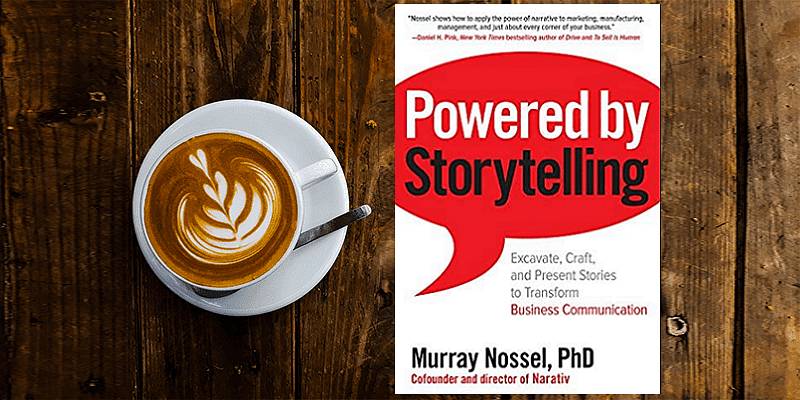Launched in 2012, YS’s Book Review section features over 300 titles on creativity, innovation, entrepreneurship, and digital transformation. See also our related columns The Turning Point, Techie Tuesdays, and Storybites.
Frameworks, examples, and tips for storytelling come together in the book, Powered by Storytelling: Excavate, Craft and Present Stories to Transform Business Communication, by Murray Nossel.
Here are my key takeaways from the 225-page book, summarised as well in the tables below. See also my reviews of the related books Once Upon an Innovation, Story 10X, Five Stars, Let the Story Do the Work, Stories for Work, Stories at Work, and Data Story.
Entrepreneurs should check out YS’s Changemaker Story Canvas, a free visualisation tool for startups and innovators. and Pitch Tips for Startups.
Murray Nossel is the Founder and Director of Narativ, a storytelling training firm with offices in New York City and London. He also teaches at Columbia University, and is a filmmaker.
“We are all keen listeners and dynamic storytellers,” Murray begins. For many people, these are latent and untapped skills – but once activated, they bring more fulfilment by uniting “our analytical abilities with our emotional intelligence.”
“In particular, when we bring the qualities of head and heart to teamwork, the result is closer collaboration, deeper bonds, and shared ownership,” the author emphasises.
He draws on extensive case studies of his experiences with storytelling workshops – coaxing shy and reserved people to speak about their experiences, helping leaders focus on meaningful stories, and even managing group disagreements about bringing emotional stories to the workplace.
Foundations
The book spells out the Narativ Method of Listening and Storytelling, building on the reciprocal relationship between listening and storytelling.
One of the most effective ways to enhance creativity is to learn how to suspend judgment. “Creativity and insight flow with non-judgment. Empathy and understanding depend on it,” Murray observes. Effective collaboration grows not just from criticism but appreciation as well.
“Humans are hardwired for story,” Murray lists as the first of seven principles of storytelling. Everyone has a story that they can learn to tell, and which will evolve. “Storytelling is every person’s access to creativity,” he adds.
“Storytelling is a skill that can be developed, a muscle that can be strengthened,” Murray explains. “A good story is the spark of communication exchange,” he writes.
Everyone has unique personal and professional stories, even on the same themes. “Your story is your birthright,” Murray affirms.
The seven steps to storytelling are divided into three phases – excavating, crafting, and presenting. The process is not always linear, and can involve back and forth moves as stories are refined over time.
“Storytelling involves both a critical mind and a creative mind,” the author shows, with a mix of generation and pruning activities.
I. Excavation
The first step is to identify the purpose and timing of telling the story or sharing a series of stories. This can include demonstrating leadership, explaining the purpose, building culture, increasing collaboration, fostering empathy and connections, inspiring change, sharing learnings and knowledge, or even resolving conflict.
The author shares settings for such stories, such as forward-thinking strategy for a tech startup, mutual connections in a global media firm, showing customer connections in an insurance company, fortifying presentations in a pharma giant, and overcoming preconceptions around a legal team.
“Listening is the container that gives shape to the telling,” Murray describes, pointing to the way the same water that is poured can fill differently-shaped containers.
The chapter on identifying obstacles to listening is outstanding (see my takeaways in the table below). Competitive cultures are not conducive to listening if employees talk past or over one another, try to dominate, or focus on multitasking during meetings, the author cautions.
It takes effort to listen without judgement, opinion, rationalisation, or distraction by one’s own daily to-do lists and deadlines. “Open listening takes a leap of trust,” Murray emphasises.
“Judgements of others and ourselves make it difficult to be generative and creative,” he cautions. This may call for reflection, self-control and even courage to unlearn prior habits.
In a group storytelling activity or even during regular meetings, it can help if participants reveal – and thus release – their obstacles to listening. Offline or online spaces should be clearly set up in advance, with agreement on rules of engagement for supportive listening.
Dedicated listeners, timekeepers and facilitators can help in this regard. Such discipline helps create safety, structure and productivity, the author shows. Stories can be recorded and shared for future analysis as well.
II. Crafting
A good way to build organisational bonds is by storytelling about one’s heritage – in particular, the “Grandparent Exercise.” Most people have fond memories of their grandparents, Murray explains.
He shares a case study of a corporate storytelling workshop where some grandparent stories moved the narrators to tears. Others, however, felt uncomfortable discussing their grandparents’ involvement in wars, while yet others felt that such personal emotions should not be brought into the workplace and cause discomfort.
Though they may be controversial, such training can also be memorable and transformative, the author observes. They can bring about a deeper understanding of other cultures.
“Storytelling has the power to transform,” Murray writes. “Stories dimensionalise us,” he adds.
Contrary to other storytelling practitioners who advise filling stories with feelings, Murray advocates stripping away interpretations, feelings, opinions, thoughts, morals, commentary, and judgements.
Instead, the focus should only be on descriptions through the senses – sight, hearing, taste, smell, and touch. This helps listeners create the experiences for themselves, thus leading to the co-creation of the story between narrator and listener.
“Let your listeners be free to make up their own moral or lesson,” the author advises. This method of storytelling, however, takes lots of practice and self-control. It can be effective in knowledge stories, origin stories, and motivational stories.
“One of the greatest difficulties with detail is choosing what to keep in and what to leave out,” Murray observes. “Detail has to serve the story,” he adds.
An interesting activity to practice here is to tell a story about a significant or meaningful personal object. Another activity is listing ten key incidents in one’s life, and preparing stories about each of them.
The story arc should consist of a beginning, emotional turning point, and end. The actual narration can actually begin in the middle of the story as well – this can pique the listener’s curiosity.
The author shows how he excavated a story for a media manager by “following the scent of a better story” and identifying key sensory descriptions. The turning point was identifying and overcoming failure, which made for a good origin story for the leader.
III. Connect with the audience
Finally, connecting with the storytelling space and audience takes time and practice. The concluding material in the book, however, does not seem as strong as the earlier chapters.
“A story lives in your body,” Murray describes. “Your body remembers your story, and therefore your body is an instrument of telling,” he adds.
Meditation helps prepare the mind, and the narrator should experiment with speaking from a podium or walking around, with or without a mike – but making eye contact with the audience.
“Presentation takes practice, experimentation, improvisation, and some courage,” the author writes. True connection happens when the audience relives your story in their heart and mind.
“Visionary leaders harvest stories for insights, utilise them to share knowledge, and employ them to foster genuine connection,” Murray signs off.
YS has also published the pocketbook ‘Proverbs and Quotes for Entrepreneurs: A World of Inspiration for Startups’ as a creative and motivational guide for innovators (downloadable as apps here: Apple, Android).







